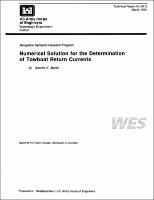Please use this identifier to cite or link to this item:
https://hdl.handle.net/11681/13366| Title: | Numerical solution for the determination of towboat return currents |
| Authors: | Navigation Hydraulics Research Program (U.S.) Martin, Sandra K. |
| Keywords: | Numerical models Mathematical models Schijfs equations Two-dimensional depth-averaged model Potential flow STREMR Return currents Towboats Inland navigation Waterways Hydrodynamics |
| Publisher: | Hydraulics Laboratory (U.S.) Engineer Research and Development Center (U.S.) |
| Series/Report no.: | Technical report (U.S. Army Engineer Waterways Experiment Station) ; HL-94-2. |
| Description: | Technical Report Abstract: In shallow-draft waterways, commercial towboats and barges generate complex currents as they move through the waterway. The flow, in general, moves from bow to stern as the tow moves forward. The current acting in the direction opposite tow movement and generally parallel to the bank is called the return current. The magnitude of the return current is generally determined using an analytical approach based upon the energy equation along a single streamline. This method gives only one, average value of the longitudinal component of the return current at a section mid-distance along the length of the tow for the entire width of the cross section. It is based on several assumptions including a uniform section, nonviscous flows, negligible ambient current, and center-line placement of the vessel. This study explored the use of a two-dimensional numerical model, STREMR, for the solution of the irrotational (potential) flow equations in the modeling of the vector field produced by a tow. The intent was not to develop a code for moving boundary problems nor to investigate the highly three-dimensional forces near the tow, but to determine the appropriate methodology and the potential applicability of using an existing tool in the determination of the tow-induced currents in a natural river. Successful use of this type approach could lead to the determination of tow-induced currents in irregular channels, with tows having off-center sailing lines, and in rivers with ambient currents. |
| Rights: | Approved for public release; distribution is unlimited. |
| URI: | http://hdl.handle.net/11681/13366 |
| Appears in Collections: | Technical Report |
